|

by
Sterling D. Allan with
Hank Mills
Pure Energy Systems News
October 28, 2011
from
PESN Website
On October 28, 2011, Andrea Rossi
demonstrated
his 1 megawatt E-Cat system to his first
customer,
who had engineers/scientists on hand to
test/validate its performance.
Due to a glitch, it provided 479 kW of
continuous power
for 5.5 hours during the self-sustained
mode.

Well, the big day has come and gone.
Andrea Rossi's
one-megawatt-capable
E-Cat cold fusion device has been tested in Bologna, Italy; and
the unknown customer, who ran the test, is apparently happy.
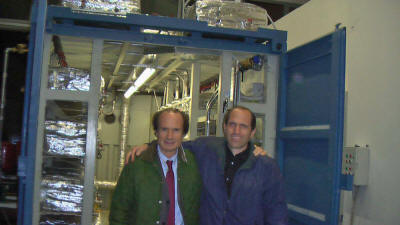
Here I am with Andrea
Rossi
after the test of the 1 MW E-Cat plant in the background.
There were some issues, so it couldn't be run at full power in
self-looped mode, but what it did do was plenty impressive.
It ran for 5.5 hours producing 479 kW, while in self-looped mode.
That means no substantial external energy was required to make it
run, because it kept itself running, even while producing an excess
of nearly half a megawatt. Rossi explained the reasons for this in
the presentation he gave, which I videotaped and will be posting
later.
That's half the rated capacity, but it is still a major
accomplishment for the device that was completed earlier this week - the first of its kind on the planet.
Early in the day with a glitch showing up, Rossi said that they had
to make a decision about whether to go for 1 MW output, not in
self-sustain mode, or with self-sustain mode at a lower power
level.
The customer opted to go for the
self-sustain mode. Nothing was said about the prospects of a
follow-up test, though I would imagine that the customer will be
running many tests to understand this gadget they have purchased,
and that information will be conveyed to Rossi.
When I asked him during the Q&A session if the customer was
satisfied with the test, Rossi responded,
"Yes, I think they are satisfied."
Here is a brief
video
excerpt highlight from Rossi during his 1-hour reading of the public
report from the customer, followed by a question and answer session.
I recorded the entire presentation, and
we'll post that tomorrow, hopefully along with a transcription.
Half the time was in Italian, as he would address each item in
Italian as well as English.
In this excerpt, Rossi responds to the question,
"So, is this a
breakthrough?"
Here's a transcription of the excerpt
video:
Mister
[Paolo] Soglia
has asked me if I think that the test of today is a
breakthrough. I think yes, because I think today we have seen
enough.
No more small five or ten kilowatt
units, but now we have overcame the difficulties connected with
the basic engineering to make something that... You know, to go
in self sustain mode and make 400 [actually 479] kilowatt hours
per hour... To understand that this is a breakthrough...
You can also think that hundreds of millions of dollars have
been spent to try to have a COP [coefficient of performance] of
1.1 with nuclear fusion. Today we have made a theoretically
endless COP making 470 kilowatt hour per hour of completely free
energy, free of fuel.
Yes, I think this is a
breakthrough.
Of course this is the first step, but it is a very important
first step....
Early this year Andrea Rossi announced
his plans to construct and test the world's first one megawatt cold
fusion plant.
The plant would utilize his E-Cat
(Energy Catalyzer) technology that utilizes tiny quantities of
nickel powder and hydrogen gas as fuel, while producing large
amounts of energy in the form of heat. Importantly, the energy is
produced without emitting any pollution, utilizing any radioactive
materials, or producing any nuclear waste.
Simply put, the E-Cat offers the world a
source of cheap, safe, and clean energy.
Although the exact plans for the launch
of the technology were adjusted a few times throughout the course of
this year, October 28th, 2011 was settled on for the date
of the official test of the one megawatt plant by the first
customer.
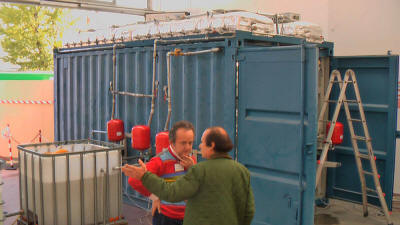

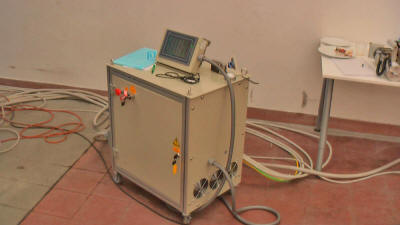
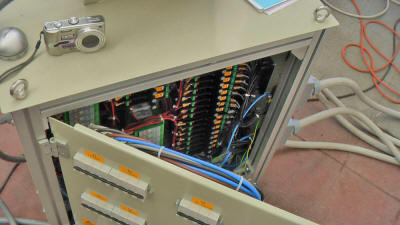
These first plants will cost around $2,000 per kilowatt to build one
at a time, but once they are mass produced, Rossi expects the price
to drop to around $100 per kilowatt installed.
Attendance at this test was limited for several reasons. First, the
customer does not wish to be known at this time, nor to have its
test engineers/scientists identified. I did not inadvertently
discover the customer's identify, nor did I try to find out.
I gave that group their space and did
not probe. Second, the device is a nuclear device, and the
regulations for a public demonstration are extremely stringent; so
by making the event private, and only bringing one or two at a time
to see it was a way to get around the safety requirements.
Most of us (around 30 guests total) arrived between 9 and 10 am; and
by around 11 am, Rossi began taking people back to see the device
while it was in operation, in self-sustained mode.
Here's a
video I
shot, with Rossi's permission, during my 2-3 minute chance to see
the unit during operation:
Power for start-up (resistive coils that
provided heat to the reaction chambers) was provided by the large
and loud genset (was making all the noise) you see that is nearly as
large as the small shipping container in which the 1 MW E-Cat plant
was arranged.
Once the reaction chambers got up to
temperature, they were maintained by the heat produced by the
reaction. I'm not sure why they kept the generator running after
that, but I would guess it was for back-up or safety. I'm sure the
engineers testing the system made sure what the power levels were at
all times.
There were 100 E-Cat modules, each with 3 reaction chambers in them,
for a total of 300 reaction chambers. An additional 20 or so units
had been installed on the top of the shipping container, compared to
the earlier photos and videos we had seen. Steam was produced by the
units and exited through the back in the bottom of the two pipes.
The steam was not put to use to run a
load but the heat was dumped via two radiators, distilled, and
circulated back into the system. When looking inside the plant, I
noticed that one of the E-Cat units had a little steam escaping from
the front of it.
The top pipe in the back, which was closed, was for emergency
cool-down, if needed.
Each unit was run independently through a computerized control. The
input and output temperature readings were recorded by computer, and
the data will be provided to us probably later this evening or
tomorrow morning. When I went by there, I think the input was
measuring 19 C, and the output was 109 C.
Radiation measurements were taken by Dr. Bianchini David,
from the University of Bologna.
He said no extraneous radiation was
detected at any time emanating from the reaction chambers, or from
the piping, or from the water tanks, or in the vicinity of the
apparatus. Apparently, gamma radiation is produced during the
reaction, which is shielded by water, iron, lead, and a final
coating on the apparatus.
David said that he has not measured
gamma radiation from the device, because he has not had access to
the reaction chamber while it has been unshielded.
None of the units were taken apart following this test, as was the
one back on the October 6 test. I asked Rossi whether any radio
frequencies were used in the test, and he said "no".
I would estimate that there were about 12 people assisting with the
test arrangement, including:
-
3-4 security guards
-
1 caterer
-
2 receptionists who checked to
make sure everyone was invited and wore the required badges
-
3-4 engineers helping take
measurements
-
Foccardi was helping take guests
1-2 at a time back to see the unit
I especially enjoyed mingling with the
other guests, including:
-
Mats Lewan from NyTeknik
-
Irene Zreick from Focus.it
-
Peter Svensson, Technology
Writer for the Associated Press, NY, who told me that the
reason the mainstream press hasn't been covering this is
because Rossi has been very picky about who he lets in
-
Enrico Billi, a nuclear
physicist and friend of Rossi's, who is presently living in
China and helping to open doors there for this technology
-
Professor Christos Stremmenos,
from the University of Bologna, who told me all about his
theory of how the technology works
-
Pierre Clauzon, nuclear
engineering professor from France, who told me about several
theoretical physicists trying to understand cold fusion in
general and the E-Cat in particular
-
Uzikova Irina, a nuclear plant
designer from Russia
-
Stefan Heglesson, representing a
Swedish interest in the technology
-
Loris Ferrari, Associate Professor of Condensed Matter
Physics from the University of Bologna, who will be one of
the five professors to do the two year test of the E-Cat,
which hopefully will be funded as a result of today's test
They will study both the "how" and the
"why" of the technology.
Mats and I agreed to post our stories at the same time. Peter
was going to go first, having been given an exclusive by Rossi, but
it's going to be a few days before he gets the necessary info and
editorial approvals before he's able to run a story in the
Associated Press.
Probably the biggest opening for skeptics will be the continually
running genset that is probably rated for 500 kW (my guess), and
appears to have been connected by cables to the E-Cat.
"Where's the mystery?"
So knock yourselves out, skeptics. It's
the customer who has to be happy, and apparently this one was
satisfied that those cables were not contributing to the 470 kW
output during self-sustaining mode.
Here's a video
where Rossi talks to us briefly following the test, saying that a
report will come shortly; and giving us the reason for why we
couldn't go back during the test except 1-2 at a time.
Links
What You Can Do
-
Pass this on to your friends and
favorite news sources.
-
Join the
H-Ni_Fusion
technical discussion group to explore the details of the
technology.
-
Once available, purchase a unit
and/or encourage others who are able, to do so.
-
Let professionals in the
renewable energy sector know about the promise of this
technology.
-
Subscribe to our
newsletter
to stay abreast of the latest, greatest developments in the
free energy sector.
-
Consider investing in Rossi's
group once they open to that in October.
-
Help us manage the
PESWiki feature page on Rossi's technology.
PESN Coverage of E-Cat
(Source)
-
LENR-to-Market Weekly - November 22, 2012
(PESN)
-
LENR-to-Market Weekly - November 15, 2012
(PESN)
-
LENR-to-Market Weekly - November 8, 2012
(PESN)
-
LENR-to-Market Weekly - November 1, 2012 (PESN)
-
LENR-to-Market Weekly - October 25, 2012 (PESN)
-
LENR-to-Market Weekly - October 18, 2012 (PESN)
-
Andrea Rossi's Black Box - by Popular
Science (PESN; October 16,
2012)
-
Penon High-Temperature E-Cat Test Results
Posted (PESN)
-
LENR-to-Market Weekly - October 11, 2012
(PESN)
-
LENR-to-Market
Weekly - October 4, 2012 (PESN)
-
LENR-to-Market Weekly - September 27, 2012
(PESN)
-
LENR-to-Market Weekly - September 20, 2012
(PESN)
-
LENR-to-Market Weekly - September 13, 2012
(PESN)
-
2012 E-Cat Conference Report: 1 MW E-Cat
Ready (PESN;
September 11, 2012)
-
September 9: Andrea
Rossi Q&A, Panel Discussion, Interview (PESN;
September 10, 2012)
-
Rossi Gives Third-Party
Test Results from Hot Cat (PESN; September 9, 2012)
-
LENR-to-Market Weekly - September 6, 2012 (PESN;
September 6, 2012)
-
2012 E-Cat Conference in Zurich
(PESWiki; August
31, 2012)
-
LENR-to-Market Weekly - August 30, 2012
(PESN)
-
A Barrel of a Hundred High Temperature E-Cats
(PESN; August 30, 2012)
-
LENR-to-Market Weekly - August 23, 2012
(PESN)
-
Existence of 1,200C E-Cat Test Report
Confirmed (PESN; August 22,
2012)
-
LENR-to-Market Weekly - August 16, 2012
(PESN)
-
Details Provided about Hot Cat Test Data
Leaker (PESN; August 13,
2012)
-
Stunning Third Party E-Cat Test Report
Details Leaked During NIWeek (PESN;
August 11, 2012)
-
LENR-to-Market Weekly - August 9, 2012
(PESN)
-
Mainstream Coverage of Fleischmann's Death
Mentions Nothing of Technology Nearing Marketplace
(PESN; August 8, 2012)
-
Andrea Rossi's Black Box - by Popular
Science (PESN; October 16,
2012)
-
Penon High-Temperature E-Cat Test Results
Posted (PESN)
-
LENR-to-Market Weekly - October 11, 2012
(PESN)
-
LENR-to-Market
Weekly - October 4, 2012 (PESN)
-
LENR-to-Market Weekly - September 27, 2012
(PESN)
-
LENR-to-Market Weekly - September 20, 2012
(PESN)
-
LENR-to-Market Weekly - September 13, 2012
(PESN)
-
2012 E-Cat Conference Report: 1 MW E-Cat
Ready (PESN;
September 11, 2012)
-
September 9: Andrea
Rossi Q&A, Panel Discussion, Interview (PESN;
September 10, 2012)
-
Rossi Gives Third-Party
Test Results from Hot Cat (PESN;
September 9, 2012)
-
LENR-to-Market Weekly - September 6, 2012 (PESN;
September 6, 2012)
-
2012 E-Cat Conference in Zurich
(PESWiki; August
31, 2012)
-
LENR-to-Market Weekly - August 30, 2012
(PESN)
-
A Barrel of a Hundred High Temperature E-Cats
(PESN; August 30, 2012)
-
LENR-to-Market Weekly - August 23, 2012
(PESN)
-
Existence of 1,200C E-Cat Test Report
Confirmed (PESN; August 22,
2012)
-
LENR-to-Market Weekly - August 16, 2012
(PESN)
-
Details Provided about Hot Cat Test Data
Leaker (PESN; August 13,
2012)
-
Stunning Third Party E-Cat Test Report
Details Leaked During NIWeek (PESN;
August 11, 2012)
-
LENR-to-Market Weekly - August 9, 2012
(PESN)
-
Mainstream Coverage of Fleischmann's Death
Mentions Nothing of Technology Nearing Marketplace
(PESN; August 8, 2012)
-
LENR-to-Market Weekly - August 16, 2012
(PESN)
-
LENR-to-Market Weekly - August 9, 2012
(PESN)
-
LENR-to-Market Weekly - August 2, 2012
(PESN)
-
LENR-to-Market Weekly - July 26, 2012
(PESN)
-
LENR-to-Market Weekly - July 19, 2012
(PESN)
-
National Instruments Provides Tools for Cold
Fusion Researchers (PESN;
July 18, 2012)
-
LENR-to-Market Weekly - July 12, 2012
(PESN)
-
The Ultimate E-Cat Cold Fusion
Transmutation (PESN;
July 8, 2012)
-
Jim Dunn's Report on LENR conference in
Williamsburg (PESN;
July 7, 2012)
-
The Rossi E-Cat Zooms Ahead of the Higgs
Boson (PESN; July 7,
2012)
-
LENR-to-Market Weekly - July 5, 2012
(PESN)
-
Scorching Solid State E-Cat Temperatures
Allow for Countless Applications (PESN;
July 3, 2012)
-
The New Solid State E-Cat
(PESN; June 15, 2012)
-
LENR-to-Market Weekly - June 28, 2012
(PESN)
-
Desperate E-Cat Detractors Spreading False
Safety Concerns (PESN; June
15, 2012)
-
LENR-to-Market Weekly - June 21, 2012
(PESN)
-
600 Celsius - The Accelerating Evolution of
Andrea Rossi's E-Cat (PESN;
June 15, 2012)
-
LENR-to-Market Weekly - June 14, 2012
(PESN)
-
LENR-to-Market Weekly - June 7, 2012
(PESN)
-
LENR-to-Market Weekly - May 31, 2012
(PESN)
-
LENR-to-Market Weekly - May 24, 2012
(PESN)
-
LENR-to-Market Weekly - May 17, 2012
(PESN)
-
LENR-to-Market Weekly - May 10, 2012
(PESN)
-
LENR-to-Market Weekly - May 3, 2012
(PESN)
-
LENR-to-Market Weekly - April 27, 2012
(PESN)
-
Brillouin: "Understanding How LENR Works Will
Enable Us to Be First" (PESN; April 19, 2012)
-
LENR-to-Market Weekly - April 19, 2012
(PESN)
-
LENR-to-Market Weekly - April 12, 2012
(PESN)
-
E-Cat Weekly - April 5, 2012
(PESN)
-
E-Cat / Defkalion Weekly - March 29, 2012
(PESN)
-
E-Cat Weekly - March 22, 2012
(PESN)
-
E-Cat Weekly - March 15, 2012
(PESN)
-
Rossi Tells Florida Bureau He Has No U.S.
Factory, No Nuclear Reactions (PESN;
March 11, 2012)
-
E-Cat Weekly - March 8, 2012
(PESN)
-
E-Cat / Defkalion Weekly - March 1, 2012
(PESN)
-
E-Cat / Defkalion Weekly - February 23, 2012
(PESN)
-
E-Cat / Defkalion Weekly - February 16, 2012
(PESN)
-
E-Cat Weekly - February 9, 2012
(PESN)
-
E-Cat Weekly - February 2, 2012
(PESN)
-
E-Cat Weekly - January 26, 2012
(PESN)
-
Rossi's Relationship With University of
Bologna Continues (PESN;
January 26, 2011)
-
Review of Sterling Allan's Coast to Coast
Interview (PESN;
January 24 , 2012)
-
Cheat Sheet for January 21, 2012 Coast to
Coast Show (PESN;
January 22, 2012)
-
Top 5 Free Energy Technologies Unfolding Now (PESN;
January 21, 2012)
-
E-Cat Weekly - January 19, 2012
(PESN)
-
Momentous Breakthroughs Announced During
Anniversary E-Cat Interview (PESN;
January 15, 2011)
-
E-Cat Weekly - January 12, 2012
(PESN)
-
E-Cat Weekly - January 5, 2012
(PESN)
-
Anniversary Interview with Rossi Slated for
January 14, 3pm MST (PESN;
January 5, 2011)
-
One Full Year of Andrea Rossi's E-Cat
(PESN; December 30, 2011)
-
E-Cat Weekly - December 29, 2011
(PESN)
-
E-Cat Weekly - December 22, 2011
(PESN)
-
E-Cat Weekly - December 15, 2011
(PESN)
-
E-Cat Weekly - December 8, 2011
(PESN)
-
Has Defkalion's President Confirmed the
Accusations of Rossi and Stremmenos?
(PESN; November 29, 2011)
-
A Week of E-Cat News Flurry
(PESN; November 29, 2011)
-
ECat.com Launched by N. Europe Licensee
(PESN; November 17, 2011)
-
Sterling Allan on the up and down of Rossi's
approval of Leonardo-ECat.com (PESN;
November 16, 2011)
-
My 11.11.11. Message on Planetary Explosion -
to Collapse or to Fortune (PESN;
November 14, 2011)
-
National Instruments signs to do E-Cat
controls (PESN; November
10, 2011)
-
Bloomberg's EnergyNow Names E-Cat as Week's
HotZone (PESN; November 7,
2011)
-
Mainstream News of Andrea Rossi's LENR E-Cat
(PESWiki; November 7, 2011)
-
E-Cat Orders Being Taken After Successful
Launch (PESN; November 3,
2011)
-
Fox News E-Cat Article Needs Work
(PESN; November 2, 2011)
-
Rossi's E-Cat Victory on Cold Fusion's
Emergence Day - E-Day (PESN;
November 2, 2011)
-
After the E-Cat Test: Report and Q&A with
Rossi (PESN; October 31,
2011)
-
Rebuttal to Krivit's Accusation that Andrea
Rossi is a Fraudster (PESN;
October 30, 2011)
-
1 MW E-Cat Cold Fusion Device Test Successful
(PESN; October 28, 2011)
-
How Much is One (1) Megawatt?
(PESWiki; October 27, 2011)
-
Tracking the One Megawatt E-Cat Test October
28, 2011 (PESWiki; October
20, 2011)
-
Cheap power: An overnight revolution - Commentary (PESN; October
16, 2011)
-
Rossi Answers Questions on the E-Cat
(PESN; October 11, 2011)
-
Cold Fusion E-Cat Case Design Competition
(PESWiki; October 10, 2011)
-
E-Cat Test Validates Cold Fusion Despite
Challenges (PESN; October
8, 2011)
-
Photos of the October 6, 2011 E-Cat Test
(PESWiki; October 5, 2011)
-
Real-Time Updates on the October 6, 2011
E-Cat Test (PESWiki;
October 5, 2011)
-
Scientists to Test Cold Fusion E-Cat
(PESN; Sept. 26, 2011)
-
Rossi's Home Sacrificed For Cold Fusion E-Cat
Launch (PESN; Sept. 21,
2011)
-
The Ultimate Ni-H Cold Fusion E-Cat Test
(PESN; Sept. 16, 2011)
-
Rossi's 1 MW Cold Fusion E-Cat Reactor Photos
and Video Posted (PESN;
Sept. 14, 2011)
-
More Uncertainty as Ni-H Cold Fusion Launches
Near - NASA (PESN; Sept. 6,
2011)
-
Rossi-Defkalion Split Controversy
- index of articles (PESN; Aug. 7,8, 2011)
-
E-Cat Competitors Revealed During Viareggio
Conference (PESN; July 25,
2011)
-
Rossi's Self Sustaining One Megawatt Reactor
(PESN; July 21, 2011)
-
E-Cat News Coming Fast and Furious
(PESN; July 14, 2011)
-
EV World Interviews Andrea Rossi
(PESN; July 14, 2011)
-
Hitler Panics Over Rossi's Energy Catalyzer
(PESN; July 5, 2011)
-
Cheap Cold Fusion to Save World Billions
(PESN; July 3, 2011)
-
Defkalion Press Conference Reveals E-Cat
Rollout Plans (PESN; June
25, 2011)
-
A Nobel Laureate speaks out on the Energy
Catalyzer (PESN; June 23,
2011)
-
Rossi Explains E-Cat Setup in New Video
(PESN; June 21, 2011)
-
Defkalion Announces Energy Catalyzer Press
Conference (PESN; June 17,
2011)
-
Cold Fusion #1 Claims NASA Chief
(PESN; May 31, 2011)
-
Ampenergo Amps Up Rossi's Energy Catalyzer in
America (PESN; May 17,
2011)
-
Seven Reasons to Embrace Rossi's Energy
Catalyzer (E-Cat) (PESN;
May 7, 2011)
-
NyTeknik Validates Rossi's Energy Catalyzer
(PESN; May 2, 2011)
-
Sterling Allan on Cash-Flow: "It's an act of
revolution to support free energy."
(PESN; April 28, 2011)
-
Rossi Cold Fusion Validated by Swedish
Skeptic's Society (PESN;
April 7, 2011)
-
Breakdown to Breakthrough is Possible Now
(PESN; March 25, 2011)
-
Andrea Rossi with Sterling Allan on Coast to
Coast AM (PESN; March 24,
2011)
-
Rossi's Cold Fusion Energy Catalyzer:
Frequently Asked Questions (PESN;
March 21, 2011)
-
Sterling Allan Appearing on Coast to Coast
AM March 23, 2011 (PESN;
March 18, 2011)
-
Welcome Worry-Free Nuclear Power: Rossi's
Energy Catalyzer (PESN;
March 17, 2011)
-
Cold Fusion Steams Ahead at World's Oldest
University (PESN; March 7,
2011)
-
Future Impact of Rossi's Cold Fusion
(PESN; February 28, 2011)
-
Rossi's cold fusion reactor achieves 15 kW
for 18 hours (PESN;
February 22, 2011)
-
BlackLight Power vs. Rossi's Cold Fusion -
Related Technologies? (PESN;
February 8, 2011)
-
Fear Mongering: From Cannabis to Cold Fusion
(PESN; January 23, 2011)
-
Fighting the Infection of Cynical Skepticism
with Cold Fusion (PESN;
January 21, 2011)
-
Hope Grows as Journals Weigh in on Italian
Cold Fusion Breakthrough (PESN;
January 19, 2011)
-
Cold Fusion getting hot with 10kw heater
prepping for market (PESN;
January 17, 2011)
-
Multi-kilowatt Ni-H cold fusion demo under
way January 14 in Italy (PESN;
January 14, 2011)
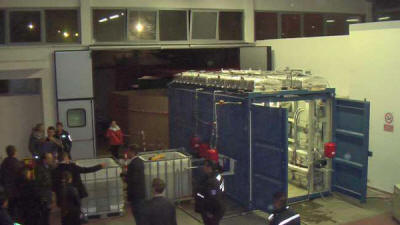
1 MW unit tested on
October 28, 2011.
Photo by Sterling Allan
by
Sterling D. Allan
Pure Energy Systems News
May 5, 2013
from
PESN Website
We discussed the latest
E-Cat plant status;
the initial military customer plant status;
the
glowing-hot-cat, and safety considerations at this early stage,
and
their postponing of domestic product roll-out;
the Hot-Cat research
and work toward electricity generation;
the Hot-Cat 3rd party test
conditions and status...
Today, Frank Acland of E-CatWorld
and I conducted a 1.5-hour interview with Andrea Rossi
regarding developments in his
E-Cat technology which is poised to revolutionize the energy
sector by providing cheap and clean heat and electricity using a
variation of the "cold fusion" technology called "LENR" for Low
Energy Nuclear Reaction, where "low" refers to the input
temperature required to initiate the nuclear reaction in comparison
to the hundreds of millions of degrees required on the sun to
initiate fusion.
The live interview was hosted by Gary Hendershot on his
SmartScarecrow service, with
a chat room where people could post questions, several of which were
presented to Rossi during the show.
At its peak, there were just over 1000
people listening to the live broadcast, which began at 4:30 pm
Eastern time (GMT-5), with nearly 200 people in the live chat.
Rossi didn't have a webcam or headset, and his internet wasn't that
great, so his connection cut out several times. Frank didn't have a
webcam either. To conserve on bandwidth, I cut my video feed.
Though
none of us could be seen live, Gary displayed our photos/names while
we talked; and he displayed some of the images being referred to in
our discussion, such as the red-hot, glowing Hot-Cat; and the 1 MW
(heat) plant being shipped.
Here is a video
of the interview:
While from a roll-out speed point of
view, things have been progressing with this technology more slowly
than we had hoped; from a legitimacy point of view, I came away from
the interview even more convinced that the E-Cat technology is real
and poised to eventually revolutionize the energy scene, not to
mention science and the economy, while helping to clean up the
planet.
Early in the interview, Rossi explained
that the 1 MW plant that I saw demonstrated on October 28, 2011 was
not delivered to the confidential military customer.
There were many glitches that needed to
be worked through first:
"hydraulics, distribution, common
rail distribution, choice of coolant; didn't have well-balanced
distribution of 100+ of reactors."
In contrast, he said:
"The plant as of now is very
mature."
A separate unit was built for the
military customer then shipped, and Rossi said that it has now
logged "many thousands of hours" of run time. He said the data from
this plant easily corroborates the guaranteed coefficient of
performance of 6 (six times more energy out than what is put in to
make it run).
The plant that is now on its way to the U.S. customer is an upgraded
version of the unit that was demonstrated on October 28, 2011. He
just recently (April 30 - May 1, 2013) finished a 24-hour test of
the unit before preparing it for shipping; and now, it is somewhere
en route.
Rossi estimates that it will take about
20 days to transport, and it could be a month before that unit is
operational at the customer's facility, where the customer "will be
selling heat made by the plant."

Testing the unit prior to shipping.
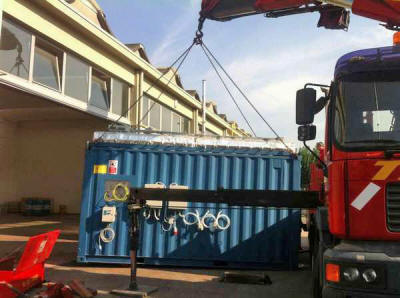
See
E-CatWorld
for more photos of the shipping process.
We had thought that this customer was
going to be publicly announced, and that the unveiling of this unit
would be public. However, at this time, it turns out that the
customer wishes to remain confidential.
"This is not a theatre."
This brings to two the number of 1 MW units that have been
completed. He said other plants are under construction.
Safety
Considerations
Rossi explained a reasonable logistical purpose for not allowing
public viewing and access to this technology at this phase of its
development.
He explained that foremost, there are
safety considerations. While limited numbers of people with adequate
safety training and precautions can access the technology, allowing
non-trained public to approach the technology presents safety
issues.
That is the primary reason why the home or domestic E-Cat is
presently on hold. The certification and safety agencies that need
to sign off on something like this require extensive testing before
they will approve of it to be made available to the general public.
By taking the approach of first rolling this product out as a 1 MW
industrial unit, each of which contains 106 individual modules,
those installations will accumulate the safety record that can be
referred to for the next stage, which would be introducing the
technology to the general public. The 1 MW units only run at
temperatures of 102 - 130ēC.
Rossi said that these plants consume only 1 gram of Nickel for every
23 gigamegawatt-hours of heat they produce (that's
23,000,000,000 Watt-hours of power).
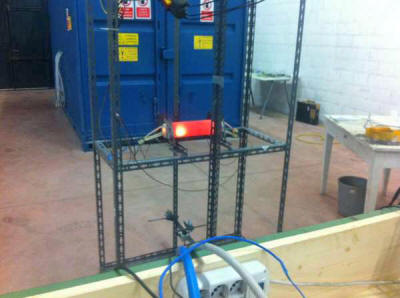
Also, we asked Rossi about the
red-hot-glowing Hot-Cat
image that Daniel Passarini posted this past week. Rossi said
that this photo had been leaked, notwithstanding NDA terms that
prohibited it, and that it was a unit being purposely tested to
destruction, from which they learned much about the process.
They put it in self-loop mode and turned
off the regulation. It is not at all intended to be representative
of normal operation.
Electricity
Production
Rossi said that the Hot-Cat runs at 350ēC and is "very stable."
At
this temperature, he said that creating electricity will be easy,
and that they are making progress on building such embodiments.
Later in the interview, in response to a question:
"Is Andrea Rossi
still working with Siemens to generate electricity?" he replied to
the affirmative, but said that the conditions were under NDA and he
was not at liberty to elaborate.
Frank asked Rossi to comment on a statement he made one time to the
effect that he had observed the creation of electricity directly
from one of the reactors (without going through a turbine or other
thermal-electric converter).
At first, Rossi shied away from the
question, but then said that they had observed some,
"strange phenomenon, found by
serendipity - a sensation that we produced direct current." But
he said: "We are far from being at the point to say we have
direct production of electricity from this process."
Third-Party
Testing of Hot-Cat
Regarding the 3rd-party testing of the Hot-Cat design, Rossi gave
the following information.
-
Testing was conducted from March
18-23
-
Included 120 hours of continuous
running, with no interruptions
-
Included four professors from
different parts of the world (names are confidential for
now)
-
Was very expensive
-
The tests were run in the
absence of Rossi, though he was available if they had any
questions
-
Tests were done with their
instrumentation; they controlled the cabling
-
Rossi still doesn't know the
exact results but said they were "smiling" and indicated
that it was "very good"
-
The report will be published in
a peer-reviewed journal, which takes some time
The Team
I asked Rossi to elaborate on who "we" entails when it comes to his
team. He replied:
-
2 specialists working on
electronics for the control systems. They have made enormous
progress in the last 7-8 months. They also work on any kind
of thing connected with electricity.
-
3 specialists working on thermal
technical problems: thermal dynamics, upgrade heat exchange;
upgrade the energy density.
-
2 specialists working on design,
both external aesthetics as well as functionality and space
utilization for energy density optimization.
-
Team that makes tests of plants,
to run plants; to invent new things that improve efficiency.
-
Manufacturing team.
-
Another team working on
prototype design in the U.S. (for 1 MW plants)
He said that most of the R&D will stay
in Italy, but that the rest of the operations are taking place in
the U.S. (Florida).
However, later, he talked about the
friendliness of Sweden to his company, due to their need for heat
and their environmental consciousness. They are in process of
developing manufacturing capability there as well.
He also talked about the reason why they are developing robotics for
their manufacturing. "There are 106 modules in one 1 MW plant. To
build 1000 one-megawatt plants would involved 106,000 reactors.
As to how Rossi screens his potential customers, he said that a
major criteria he looks for is whether or not the customer presently
uses some kind of heat-generating mechanism.
If they have real needs, it diminished
the possibility that they just want to get the unit to harvest the
intellectual property.
Cat and Mouse
Hank
Mills, who was listening to the show via our Skype connection,
chimed in with a couple of technical questions, one of them being to
have Rossi describe what he means by "cat and mouse."
Rossi explained that each module has essentially two apparatuses
inside: and activator and the reactor. He calls the resistive heater
element the "mouse" and the reactor the "cat".
It takes a little tease from the mouse
getting in front of the cat's nose for the cat to go off running. He
compares this to the little amount of energy required to get the
reaction going, using outside electricity to bring the resistive
heater up to a temperature that the reaction takes place.
Of the two components, the reactor is
only "the size of a glass of whiskey".
Patent
The other question from Hank had to do with a discussion of Ni62 in
the patent.
"This is because I have seen
isotopes of 62 and 64 work properly in our process," Rossi
responded.
He said that the Italian patent granted
in 2009 gives them priority on the technology; and that they have a
lot of applications they are working on filings for.
Licensing
While he appreciated the question,
"Many people are likely to want to
adapt this technology to products they make - can they license
it?" he said that such questions were premature, given how early
they are in the technology development.
They are focusing on the modules that go
into the 1 MW plants for now.
"Specific applications will come
later on."
Lead Time
As for how long people could expect to get delivery of a 1 MW plant,
Rossi said it would be "around four months." We didn't ask him about
price, but a of a couple of years ago, it was $1.5 million USD.
Thanks to JONP
Comments
Since before he announced the press conference for the 5 kW E-Cat
demo on January 14, 2011, Rossi has been running a discussion forum:
Journal of
Nuclear Physics. In response to the question: "What are some
of the most important things you have learned from JONP readers?"
Rossi said he liked that question. "If you go to the Journal, you
will see 14,000 comments. They provide tremendous information. I
read all the comments with much attention. I have learned many
things."
He even said that two of the people he hired for his team were
people who commented in the forum.
Regarding a question about how the industrial world in general has
responded, he said that most of the responses have been coming from
young people, who see opportunities for a better future.
Realizing
Tesla's Dream?
Rossi said he has had a dream of realizing Nikola Tesla's dream,
which to him entails "making big energy with small components."
What You Can Do
-
Consider purchasing a 1 MW
(heat) E-Cat plant.
-
See
Suggestions for How to Get Involved with the Roll-out of
Exotic Free Energy
-
Pass this on to your friends and
favorite news sources.
-
Click to Tweet: http://clicktotweet.com/bXUoI
-
Subscribe to our
E-Cat
newsletter.
-
Let professionals in the
renewable energy sector know about the promise of this
technology.
-
Subscribe to our general
newsletter
to stay abreast of the latest, greatest developments in the
free energy sector.
|









